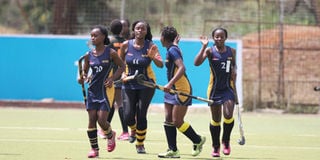Sports media guilty of portraying women as sexual objects

From left: USIU players Veronica Maua, Beatrice Mbugua, Rachel Wangui and Rhoda Kuira celebrate one of Kuira's goals during their Kenya Hockey Union women's Premier League match against Multimedia University at City Park Stadium on September 16, 2017.
What you need to know:
- Whether it be through objectification or the use of sexist language, the sports media industry plays a significant role in the continued negative portrayal of female athletes.
- I followed the debate online and came across a tweep by the name Tomapples who tried to play down the issue by saying that “…were we not so fixated on sex, innuendos and euphemisms, we wouldn’t be judging this headline as such.”
Two weeks ago in one of the leading local newspapers, a page lead story ran with the headline: “Why Adhiambo is itching for the stick once again”.
It was an ordinary story about a hockey player who was longing for the return of on-pitch action, but it was also exhibit A of abhorrent journalism.
On the adjacent page was a story about Gor Mahia players gearing up for the resumption of the league, but the editor never talked about the players itching for their balls.
As is the norm with such salacious things, the story was widely shared, and a mini debate ensued on Facebook and Twitter about whether the choice of words was indeed wrong, or if it was just another case of whiners failing to appreciate an editor’s creativity.
The editor in question is my good friend so I won’t go into whether the headline was appropriate or not, but let us focus on the broader issue.
Why does the media tend to represent women athletes as women first and athletes second? Has anyone noticed that the coverage of women in sports is often dominated by references to appearance, age or family life, whereas men are depicted as powerful, independent, and valued athletes? This unbalanced attention may seem minimal to some, but is discrimination nonetheless.
In an article titled “Objectification in Sport Media: Influences on a Future Women’s Sporting Event” , researchers Lindsey Darvin and Michael Sargas argue that “despite the tremendous increase in female participation, sport as an institution continues to perpetuate male dominance in society.”
Throughout the academic paper, Lindsey and Michael state that although much progress has been made over the last century in portraying women as legitimate athletes, there are still many ways in which they continue to be marginalised.
Whether it be through objectification or the use of sexist language, the sports media industry plays a significant role in the continued negative portrayal of female athletes.
I followed the debate online and came across a tweep by the name Tomapples who tried to play down the issue by saying that “…were we not so fixated on sex, innuendos and euphemisms, we wouldn’t be judging this headline as such.”
He went on to explain, or “mansplain”, that the headline was ambiguous and that only those who were within the prism of the Kenyan urban context would get it, and that those who understood the contemporaneous innuendo did so because of their cultural dispositions, bias and perceptions.
Needless to say, Tomapples didn’t pause to think about how the headline might have made Adhiambo feel, or her parents or even friends.
Going forward perhaps the media, myself included, could stop with the infantilisation. It is common for the media to describe women as girls.
The problem is not with women being called girls, but that it only applies to women. Men continue to be called men. Even our women’s football team go by the name “Starlets”, when their male counterparts are the actual “Stars”.
Secondly, can we focus more on actual sports related stuff instead of giving attention to women’s personal lives, appearances and families?




